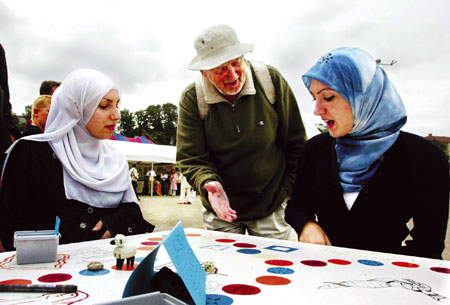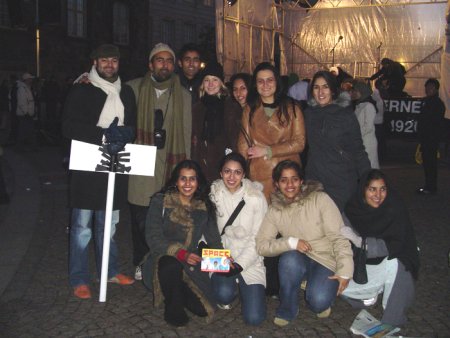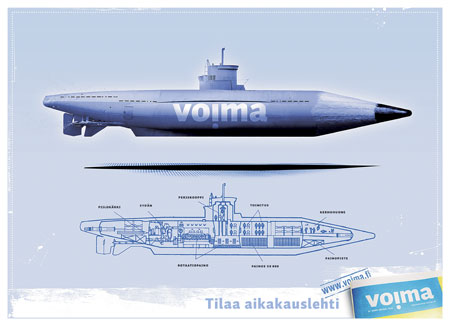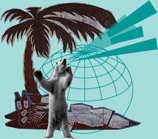Act 5: Denmark, Finland, Norway & Sweden, November 25, 2006
Documentation DVD & WEBSITE Launch
Four simultaneous launches on November 25, 2006 @
Overgaden Institute of Contemporary Art
Overgaden neden Vandet 17, DK-1414 Copenhagen K
from 5 – 8 pm
NIFCA, Nordic Institute for Contemporary Art
Suomenlinna B28, FIN-00190 Helsinki
from 5 – 10 pm
Torpedo Kunstbokhandelen
Hausmannsgate 42, N-0182 Oslo
from 5 – 8 pm
Konsthall C
Cigarrvägen 14, S-123 57 Hökarängen
(Stockholm)
from 5 – 8 pm
Act 5 consists of the production and launch of a DVD & WEBSITE. Both collect and document the rich body of aesthetic and theoretical reflections generated during the first four acts. In addition, they contain a series of interviews and essays produced specifically for Act 5. On November 25, 2006, the documentation DVD & WEBSITE are launched to the public during a series of simultaneous closing events in Copenhagen, Helsinki, Oslo, and Stockholm. With the fifth act, the project’s many postcolonial voices reach the once-colonizing countries of the Nordic region and become audible to their populations – and to the world at large.
CONTRIBUTORS
Pia Arke (Greenland/Denmark)
Bolette Benedictsen Blaagaard (Denmark/The Netherlands)
Reina Lewis (United Kingdom)
Kobena Mercer (Ghana/United Kingdom)
New Meaning (Norway)
Slut (Sweden)
VISION – den om lighed (Denmark)
Voima (Finland)
+ all participants in act 1 – 4
PIA ARKE
Born 1958 in Scorebysund, Greenland. Lives and works in Copenhagen, Denmark.
Pia Arke is a visual artist, who works with photography and text primarily. She graduated from the Royal Danish Academy of Fine Arts in Copenhagen in 1993 and holds two additional degrees from that institution: a Cand.Phil. in Art Theory from the Department of Art Theory and a Multimedia Design degree from the School of Media Arts. Arke has exhibited in a large number of contexts and has completed several public art commissions for the Danish Polar Center, Ministry of Defence, and the Environmental Investigations of Denmark, among others. Arke is the recipient of the 1999 award from the Danish Arts Foundation and in 2000, she received a 3-year work grant from the Danish Arts Foundation.
To Act 5, Pia Arke contributes with the essay “Etnoæstetik” (Ethno Aesthetics), first published by the Danish art magazine ARK in 1995 under the same title. In the foreword of the publication, Arke’s brother Erik Gant wrote: “Ethno aesthetics is something unclean, a subdivision of the ethnic, which connotes the cross breed, the domesticated wild. Ethno aesthetics is concerned with the art of placing oneself between two chairs; an art or a series of feats that we cross breeds must perform at all times. If we are something, we are both something else and the same. If not, we are neither one nor the other. In a way, we are talking about something political and something very aesthetic at the same time because the ethnic, the cross breed, indicate that which is nothing in itself, that which is something only by virtue of something else, which is not the case itself, but an image or a rewriting. And we – who perform our cross breeding all the time – have the possibility of becoming good examples, examples to be followed by others who fumble in search of their identity. In some way, we have a better, clearer, less private case. And Pia Arke’s essay exemplifies how this at the same time clear and indeterminable case can be developed.” [Erik Gant, 1995]
BOLETTE BENEDICTSEN BLAAGAARD
Born 1975 in Faaborg, Denmark. Lives and works in Utrecht, The Netherlands.
Bolette Benedictsen Blaagaard is a Doctoral Candidate and a Marie Curie Fellow at the Gender Studies Program at Utrecht University. She holds a MA in Journalism and Cultural Studies from the University of Southern Denmark. Blaagaard is an active member of the EU supported European network of Women’s Studies, ATHENA, where she contributes to developing a curriculum in European postcolonial studies. Furthermore, she is organizing a sub-group working with critical whiteness studies in a European context. Blaagaard’s work is centered on the journalistic and public representation of Nordic whiteness, and how this representation works within and alongside a Nordic imaginary and self-identification. Within this imaginary lies understandings of the past as both being used actively in constructing a sense of self (as in the case of the Icelandic sagas and the Viking myths), and being suppressed in order to sustain this sense of self (as in the case of the Southern colonies and the slave trade). Blaagaard has been published in Nordicom Information (2005) and in European Journal of Communication (forthcoming).
Critical whiteness studies are rooted in critical race theory and in African American studies. In the paper “Relocating Whiteness in Nordic Media Discourse,” Blaagaard attempts to move the scholarship from the all American context to a particular Nordic relation to the concept of whiteness. This move results in whiteness no longer being solely a part of a binary power structure, but also functioning as self-identification in a construction of a national identity. Blaagaard grounds the Nordic representation of whiteness in the journalistic and public representation of whiteness in the Nordic – and in particularly Danish – media discourse. She argues that the Nordic region in several ways is the epitome of whiteness in the Western and Nordic European imaginary, and as such whiteness easily becomes at the same time the norm and invisible – everything and nothing – which is reflected in the journalistic representations. Moreover, the paper aims not only at looking at whiteness merely as another ethnic or racial group or as a symbolic way of thinking, but at emphasizing the power structures, which makes this color what it is (hooks, 1990), so that critical whiteness studies in a Nordic and a broader European context become, what Toni Morrison has called, “the impact of racism on those who perpetuated it.” (1992) Using the journalistic representation and discourse as object of analysis, Blaagaard in this paper unravels the underlying assumptions of the Nordic imaginary as it is constructed in the dynamics of media production. [Bolette Benedictsen Blaagaard]
REINA LEWIS
Born in London, United Kingdom Lives and works in London.
Reina Lewis is Professor of Cultural Studies at the University of East London. She is author of Rethinking Orientalism: Women, Travel and the Ottoman Harem (2004), Gendering Orientalism: Race, Femininity and Representation (1996), and co-editor of Feminist Postcolonialism: A Reader (with Sara Mills, 2003). Reina Lewis is series co-editor, with Teresa Heffernan, of Cultures in Dialogue, a book series that reprints with critical introductions selected travel writings by Western and Middle Eastern women. She is also co-editor, with Peter Horne, of Outlooks: Lesbian and Gay Sexualities and Visual Cultures (1996), and has other articles published on lesbian and gay literary culture, fashion, photography, and queer theory. Her current research is on the contemporary commodification of Muslim femininities in fashion retail and in popular culture, and on the neo-Orientalisms evident in responses to Turkey’s bid for EU accession.
Reina Lewis participates with the paper “Gender, Orientalism and Postcolonialism.” This paper explores the ways in which colonial and postcolonial cultural and social relations are gendered, looking historically at the development of Western Orientalism and contemporary neo-Orientalisms. Arguing that the image of the veiled and sequestered woman of the Muslim harem has been a focal point in the construction of Europe’s imagined differences between the “East” and the “West,” the paper discusses examples of Orientalism in selected visual and literary cultural forms from the past two centuries. These images of the harem – often depicted as a sexualized realm animated by cruelty and excess – bore little relationship to the lives of the women and families who actually inhabited the segregated domains of Islamic society. But they were powerfully influential on Western popular consciousness about the East and contributed to the formation of Western foreign and imperial policies. However, dominant stereotypes about harem life did not go uncontested, and the paper examines the alternative strands of Western women’s visual Orientalism and the interventions made by women who were themselves living in Islamic societies. This focus on Western and Middle Eastern women artists and writers reveals “dominant” Orientalism to be variable and contradictory, suggesting that imperial and colonial power operated in uneasy relationship to contestatory strands from within and without. Continuing this focus on the gendered agency of resistant subjects, the paper concludes by asking what is at stake in the continued hyper-visibility of the veiled woman circulating in contemporary media, culture and politics? [Reina Lewis]
KOBENA MERCER
Lives and works in London, United Kingdom.
Kobena Mercer is Senior Research Fellow in the Department of Visual Culture and
Media, Middlesex University, London. He has taught at New York University and
University of California, Santa Cruz, and in addition to his numerous publications on the
visual arts of the black diaspora, he is editor of “Cosmopolitan Modernisms” (2005)
and “Discrepant Abstraction” (2006) in the Annotating Art’s Histories series published
by inIVA and
MIT.
Kobena Mercer participates with the paper “Black Britain as a Problem Space in Global Culture.” In his outline of the paper, he writes: “Within the next few years London will see the creation of three purpose-built arts centres to provide permanent spaces for ‘black British' artistic production. This new phase of ‘institution-building' comes at a time when the retrospective assessment of the creative activities that have placed ‘black Britain' on the world map over the past twenty years has identified a blockage in the practice of art criticism and historiography. In this essay, I address the contemporary moment as an ambiguous plateau in which our criteria for ‘success' and ‘failure' are in doubt. Attempting to dismantle some of the unspoken rules and norms that inhibit critical discourse on the aesthetic dimension, which result in reductionist tendencies towards textualism and contextualism, I turn to the late work of Raymond Williams (1989) so as to develop the assessments provided by Stuart Hall and Jean Fisher in Shades of Black (2004) within a culturally materialist account of the black British arts scene as a late 20th century diaspora formation. The relevance of ‘black British' experiences to postcolonial formations in Scandinavia and elsewhere is, on this view, best measured not by ‘successes' or ‘solutions' but by the ways in which our critical reflection on specific problems in art and politics can address contemporary difficulties.” [Kobena Mercer]
NEW MEANING
Based in Oslo, Norway.
New Meaning is a forum that aims to give young people with intercultural backgrounds the possibility to voice their opinions to the public. New Meaning wants to offer young people a chance to use their resources and become active contributors and creators within the society they live in. New Meaning has initiated and produced magazines, web-casts, board games, live entertainment events, and workshops. New Meaning wishes to expand its communication to help broaden the understanding and knowledge between different cultures. The contributors are between 18-30 years old, living both in Oslo and Trondheim. More info at: www.newmeaning.no. New Meaning magazine was first launched in May 2000 and since then six issues have been released. The magazine is not focusing on a special theme, but on the needs and interests of the contributors. We have had courses in digital photography editing and publishing allowing the contributors to design their own layout. New Meaning magazine is distributed for free to libraries, refugee camps, education institutions for foreigners, Nordic art institutions, cafés, and other public places.
New Meaning Radio is an audio magazine. Several of the audio pieces are in the contributors’ own language – Swahili, Kurdish, Gaelic, Persian, and Portuguese – and everything is translated into Swedish, Norwegian, and English. New Meaning Radio has been officially released through the Swedish National Broadcasting channel (SRC) and the Norwegian National Broadcasting channel (NRK) (see www.sr.se/p1/src/familjen/familjen.html and www.nrk.no/ulyd/4927719.html).
The Big Islamic Board Game aims to trigger conversations between non-Muslim and young Muslim girls. By taking part in the board game, the audience can have a personal encounter with Islam and a contact with another reality than the one given to us by the media.
New Meaning contributes to Rethinking Nordic Colonialism’s documentation DVD and website with a series of interviews with approximately 5 different residents in Oslo on the topic of Nordic (post)colonialism. All of them have been involved in working with New Meaning at different levels. Some of them have their origins in former colonized countries. The focus of our conversations will be how they personally relate to the theme and what their associations are. Furthermore, New Meaning will host the DVD & WEBSITE launch in Oslo, November 25, 2006. [New Meaning]

Sara Ghanoum, Rune Ljungberg & Aseel Shakfan playing the Big Islamic Board Game during the Fritt Forum festival in Gothenburg. Courtesy of New Meaning.
SLUT
Based in Stockholm, Sweden.
Slut is a feminist and anti-racist magazine produced in Sweden. One of our ambitions is to raise the level of the Swedish debate on racism, a debate where many participants until recently equated racism with right-wing extremism and took no interest in discrimination in the job market, in the housing market, in political life, or in the media. Since the end of the 1900s the Swedish debate has turned. The interest in the extreme right has faded, and at the same time the existence of ethnic discrimination is now widely acknowledged. But the resistance of the 1900s to acknowledge the presence of racism at the core of our society has now been replaced by a sense of fatalism. Mainstream society now tends to describe racism as something natural and unavoidable. Another of Sluts’ tasks is therefore to raise the temperature in the debate on racism.
When looking for a name, the name Rosa surfaced. There seemed to be many role models carrying that name: Rosa Luxemburg, Rosa Taikon, and maybe foremost, Rosa Parks. The thought of Rosa Parks gave rise to the idea to name the magazine after one of the young women who preceded her. Claudette Colvin and Mary Louise Smith where both women who had refused to give up their seats to white passengers and they both did it before Parks. For different reasons, the civil rights movement chose not to use any one of them as a poster girl. They were both still in their teens. One of the women were pregnant with a man married to someone else. The choice to give exposure to the impeccable Rosa Parks was probably strategically correct, but at the same time deeply problematic.
Fifty years later the Swedish debate on racism shares some the same problems. Like the choice of Parks over Colvin or Smith presupposes that only someone whose personality is in conformity with white norms can be a victim of racism. When Swedish media write about racism, they pick stories that are just as clearcut as the case of Rosa Parks. We want to write stories that are more complicated. Claudette, Colvin or Mary Louise seemed to be good names for our magazine. But in the end we choose a name with a more open character: Slut. We're not quite sure what it means yet, but we like it. [Slut]
Slut contributes to Rethinking Nordic Colonialism’s documentation DVD and website with a series of articles and interviews on minority issue in present day Sweden. Furthermore, Slut will host the DVD & WEBSITE launch in Stockholm on November 25, 2006.
VISION – DEN OM LIGHED
Founded in 2000. Based in Copenhagen, Denmark.
VISION – den om lighed was initiated by a dozen young people with different cultural backgrounds in the year 2000. The main idea and goal behind the association was to create a platform for youth, who wanted to make a difference in their own society by working towards equality and dignity between all citizens and people without citizenship. The association is working towards its goal by creating forums for dialogue on different levels. Our focus is primarily on dialogue between minority youth and their parents, and on the community level between the minority and majority cultures. SPACE – få rum til dine tanker is a youth counseling project initiated by VISION that advice youth through chat, telephone, and a correspondence column on www.ungdomsliv.dk. VISION has also been cooperating with a great deal of different partners and various networks and has participated in several Nordic and Danish conferences concerning gender, ethnic integration, youth, cultural diversity, etc. The “Visionaries” are between 18-40 years old, with roots in Asia, the Middle East and North Africa, Eastern and Western Europe, all residing in Copenhagen. For further information, please visit www.vision-lighed.dk.
VISION contributes to Rethinking Nordic Colonialism’s documentation DVD and website with a series of interviews of 5-10 individuals residing in Denmark. They will be selected so as to draw a broad range of expressions and thoughts, revolving around current issues of problematic encounters with the “other,” and how the history of Nordic colonialism might affect the way in which we address these issues. Furthermore, VISION will host the DVD & WEBSITE launch in Copenhagen on November 25, 2006. Our motivation for contributing to the project is that we have been dealing with the debate on ethnic minorities for quite some years. In our view, the focus on the repressed history of Danish colonialism in this project is a relevant perspective. By knowing and to some extent understanding our history, we believe that previously unchallenged, suppressed motifs and ways of regarding ourselves will be let out to public contemplation and debate, thus strengthening our self-awareness and giving us new knowledge to proactively act on the challenges of contemporary society. [VISION – den om lighed]

Courtesy of VISION – den om lighed.
VOIMA
Based in Helsinki, Finland.
Voima is is an alternative paper on culture and politics. It is available free of charge (living on ads, but politically correct ads!) and it can be subscribed as well. Its circulation is now after 4 years 50,000 copies, ten times a year. Behind Voima is the independent publishing house Rosebud Books, Friends of the Earth Finland, Finnish Nature League, and a number of individuals. Voima is journalistically completely independent. [Voima]
Voima contributes to Rethinking Nordic Colonialism’s documentation DVD and website with a series of interviews of individuals with diverse backgrounds residing in Finland on the theme of Nordic (post)colonialism. Furthermore, Voima will co-host the DVD & WEBSITE launch in Helsinki on November 25, 2006 with NIFCA.

Courtesy of Voima.
